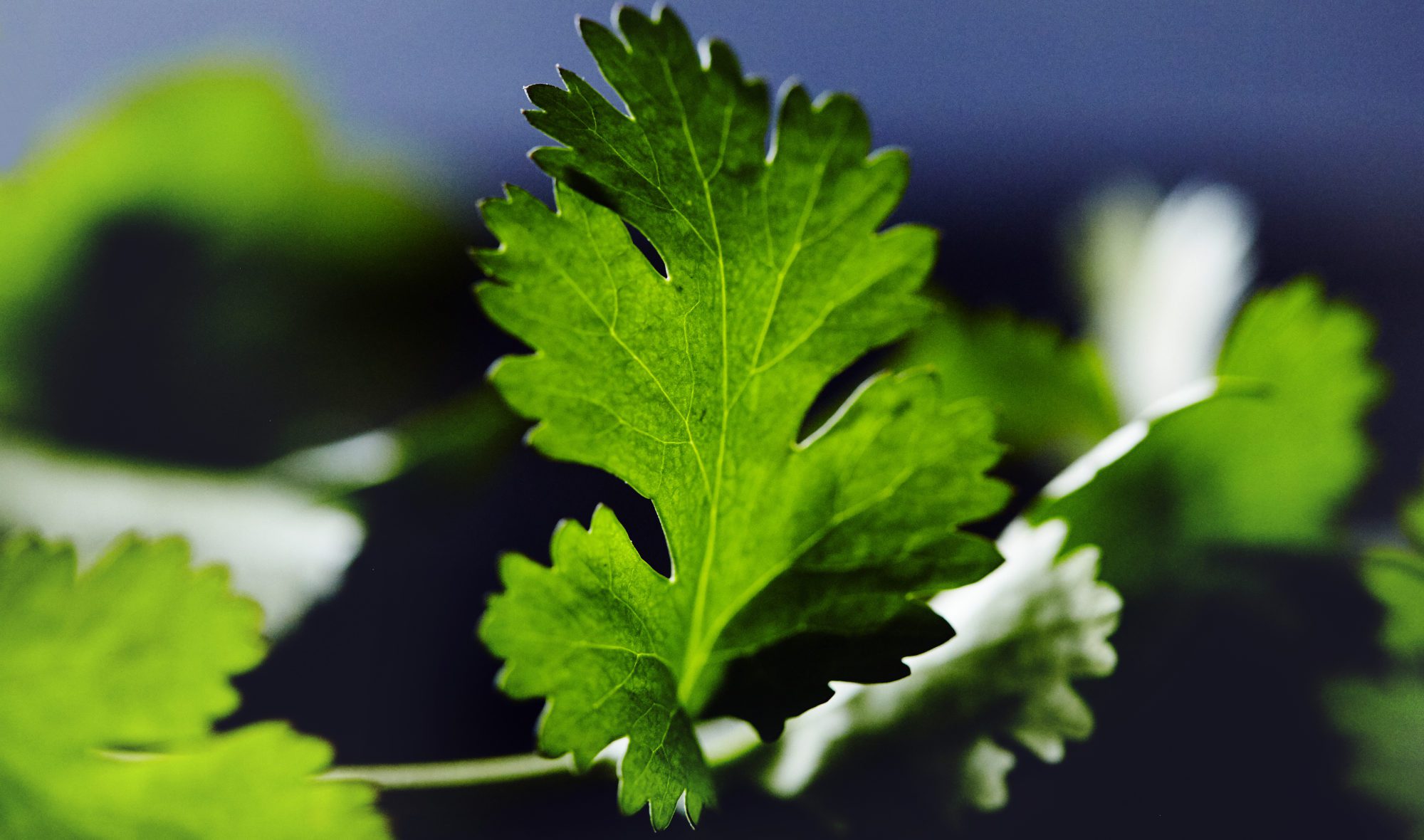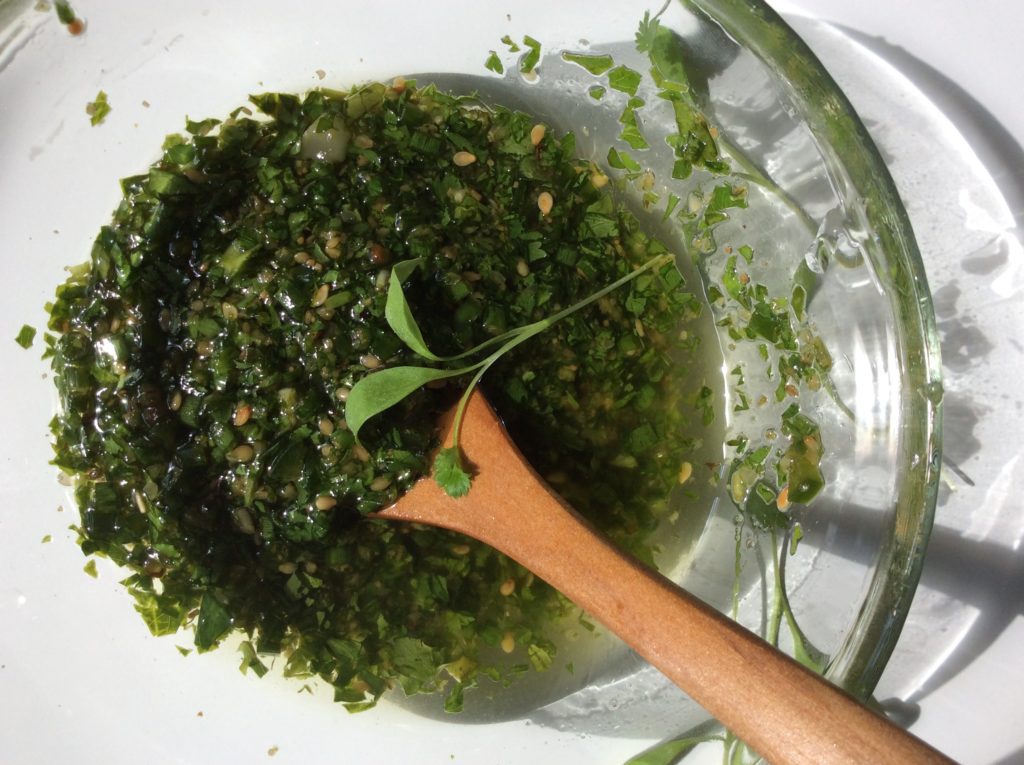Cilantro


Cilantro is a fresh herb, sometimes also called coriander leaves. It is known for its unique flavor which is clean, bright, and somewhat pungent. Many people adore the flavor of this herb, and it is used in cuisines worldwide including Thai and Mexican. However, for some tasters the flavor comes through as soapy or metallic. Cilantro offers a great nutritional punch in its small, leafy form: it contains a great spectrum of vitamins and minerals. Sprinkle cilantro on your salads, noodle dishes, curries, tacos, guacamole, barbecue chicken, and more.
Cilantro is a fresh herb, sometimes also called coriander leaves.
(Note that cilantro is different from the herb coriander, which is a commonly dried spice with a very different flavor profile.)
This prolific herb grows, and is enjoyed, in many regions around the world.
The unique flavor of cilantro is difficult to describe. It is clean and bright but also a bit pungent and spicy. For some its taste is delightful and addictive – for some it is off-putting. In fact, for some tasters, cilantro has an unpleasant soapy or metallic taste. If you happen to be one of the unlucky minority, cilantro is not for you!
Cilantro is usually available year round. During the summer months, look for it at your local farmers’ market or consider growing it in your own garden.
Cilantro is bright green, with a long stem and a flat leaf.
It can be mistaken for flat leaf or Italian parsley. To know for sure, have a sniff: cilantro has an unmistakable scent.
One-quarter cup of cilantro contains a single calorie, 0.09g of protein, 0.02g of fat, 0.15g of carbohydrates, 0.1g of fiber, and 0.03g of sugar.
Cilantro is loaded with nutrients such as vitamin A, vitamin C, vitamin E and vitamin K, as well as riboflavin, niacin, vitamin B6, folate, pantothenic acid, calcium, iron, magnesium, phosphorus, potassium, copper and manganese. It’s even a source of fiber! While you’re unlikely to eat cilantro in large enough quantities to get big amounts of these nutrients, adding this herb to your meals can give you an added dose of nutrition.
Find cilantro among the other fresh herbs in the vegetable section of your grocery store or market.
Cilantro is usually sold in bunches. Sometimes the roots are still attached — this can be a sign of freshness.
Look for bright green, relatively unblemished leaves. Avoid cilantro that is overly wilted, turning black, or showing similar signs of decay.
Store the herbs in a loose, open plastic bag in the vegetable crisper of your fridge. Cilantro will usually last about 5 days, depending on its freshness at purchase.
To extend the freshness of cilantro, as with other herbs, you may store it in a glass or small vase of fresh water, loosely covered, in your fridge. This will help keep the herb alive and flavorful for a few extra days.
To freeze cilantro try this technique: blitz a bunch of cilantro leaves in a food processor. Then add a couple tablespoons of water to the mix. Pour into an ice tray and store in your freezer. Then when you want a pop of flavor, add a cube or two to whatever you’re cooking.
Rinse the herbs with cool water. Chop the cilantro depending on your preference: you may choose to tear a few leaves off for garnish, or finely chop a big bunch.
Feel free to use the stems: chop them finely, then use as you would the rest of the herb. If roots are intact, remove and discard (or wash them thoroughly and chop finely).
Cilantro is a delicate herb so most of the time it is best added towards the end of preparing a dish, or as a garnish. However, for some preparations you may choose to add cilantro at the beginning along with other aromatics (this may be the case with some soups or curries). In this instance, roots/stems may hold up better than the leafy top.
Cilantro pairs well with other strong and bright flavors, such as coconut milk, peanut sauce, barbecue sauce, mango, onions, and chili. Cilantro is used in many world cuisines including Southeast Asian, Latin American, Middle Eastern, and more.

Light, fresh, and versatile, this salsa is amazing on fish, steak, or even tofu. You can make in advance and use it throughout the week to liven up even the simplest meals.
Prep Time: 10 minutes Cook Time: 0 minutes Yield: 1 cup
Finely chop the cilantro and add to a medium sized bowl. Combine all ingredients, except for the vinegar, and mix until combined. Add the vinegar and stir to incorporate.
Store in an airtight container for up to one week.
Enjoy!
Precision Nutrition’s Encyclopedia of Food expands every single month as we highlight new foods and showcase beautiful food photography. If you’d like to stay up to date, simply click this link. From there, we’ll send you a FREE copy of our recipe book. We’ll also let you know when new and delicious foods are added to the site.
Cilantro is a fresh herb, sometimes also called coriander leaves. It is known for its unique flavor which is clean, bright, and somewhat pungent. Many people adore the flavor of this herb, and it is used in cuisines worldwide including Thai and Mexican. However, for some tasters the flavor comes through as soapy or metallic. Cilantro offers a great nutritional punch in its small, leafy form: it contains a great spectrum of vitamins and minerals. Sprinkle cilantro on your salads, noodle dishes, curries, tacos, guacamole, barbecue chicken, and more.